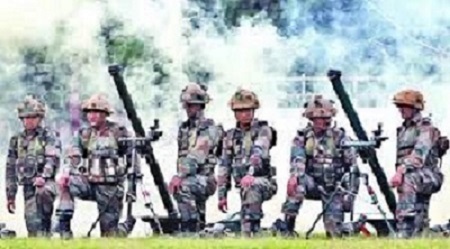Context -
The Indian military's ongoing modernization and transformation have been subjects of extensive discussion. While these terms are often used interchangeably, they differ significantly in their purpose, impact, magnitude, and scope.
Modernization vs. Transformation
- Modernization : Military modernization involves the acquisition of modern military technology and improving military effectiveness through new concepts of operations, tactics, command and control, supporting infrastructure, organisational structure, training, and personnel policies. This process includes not only acquiring modern material and technology but also appropriately linking them to the organisation, concepts of operations, tactics, command and control systems, and supporting infrastructure.
- Transformation : Military transformation, on the other hand, involves radical and profound changes in organisational culture, creating new institutions capable of facing future strategic challenges. Transformation incorporates changes based on envisioned future warfare, which demands newer force structures, operational readiness, and sustainability to respond to conflicts at all levels.
Predicting Future Warfare
- Challenges in Prediction : Lawrence Freedman, in "The Future of War," noted that "prediction is difficult and likely to be wrong." Historically, very few predictions of warfare transformation have been accurate. Current visions of future wars provide an inadequate basis for the Indian Armed Forces to transform. Yet, maintaining the status quo is unsustainable; armed forces must predict and move forward in transforming doctrines, structures, and equipment.
- PLA's Warfare Concept : The PLA's recognition of systems confrontation, system destruction, and multi-domain precision warfare as 21st-century warfare modes highlights the necessity of transformation. The PLA believes the enemy "loses the will and ability to resist" once its operational system cannot function, emphasising the theory of victory through system destruction warfare.
The Certainties of the Battlespace
- Sino-Indian Rivalry : The "Sino-Indian Rivalry" by Sumit Ganguly, Manjeet S Pardesi, and William R Thompson, notes that China outranks India in military modernization by a factor of three to five. Achieving surprise is crucial in warfighting, yet advancements in PLA's sensors make operational surprise difficult.
- China's Satellite Fleet : China has rapidly expanded its satellite fleet, with over 600 satellites, including more than 360 for intelligence, surveillance, or reconnaissance (ISR). These satellites enhance battlefield transparency through passive and active sensor arrays.
- Electronic Warfare Capabilities : China's cutting-edge electronic warfare (EW) capabilities, demonstrated in a recent encounter with US forces, underscore its advantage in multi-domain operational strategy, integrating AI and quantum technologies.
Indian Armed Forces' Operational Readiness
- Border Management : Operational readiness is paramount for the Indian Armed Forces, encompassing the ability to create, maintain, and train for balanced warfighting capabilities to achieve strategic objectives. Peace-time management of disputed borders, such as the LOC and LAC, is of prime concern.
- LOC Dynamics : The LOC serves as a de facto border with Pakistan, where ceasefire violations and terrorist infiltrations are common. Jammu and Kashmir remains a contentious issue for Pakistan, often resulting in escalated tensions and proxy wars.
- LAC with China : The LAC with China, post-2020 incursions, is characterized by mistrust and substantial Indian Army deployments. The internal security environment in Jammu and Kashmir has also deteriorated, with increased terrorist activities orchestrated by Pakistan using weapons left by US forces in Afghanistan. These developments demand a dynamic reassessment of manpower and operational commitments.
Structural and Organizational Rigidity
- Need for Flexibility : The controlled allocation of the defense budget necessitates shedding structural and organizational rigidity within the Army. War establishment tables (WE) have remained largely unchanged since independence, despite advancements in battlefield transparency and lethality.
- Sectoral Specialization : There is a need for dynamism, sectoral specialization, and re-evaluation of forces based on operational tasks. The internal assessment should focus on offsetting manpower shortages and ensuring adequate peace tenures for units to refit and retrain.
Qualitative Transformation
- Enhanced Capabilities : Qualitative transformation involves replacing existing capabilities with superior ones, enhancing lethality, precision, battlefield transparency, and establishing a digital backbone network. This transformation must align with warfighting concepts, ensuring tactical units, formations, sensors, shooters, and command and control systems are interconnected.
- Prioritization : Prioritization in qualitative transformation should conform to warfighting concepts, not as a post-mortem of technological intake.
Addressing System Destruction Threats
- Defensive Measures : Transformation must also address the threat of system destruction using missiles, rockets, EW, loitering ammunition, drones, and directed energy weapons. Hard and soft kill systems, including missile defence, electronic countermeasures, decoys, deception, missile approach warning systems, surface-to-air missiles, and anti-aircraft guns, are essential.
- Cybersecurity : Cyber countermeasures, secure communication protocols, and cybersecurity measures will enhance protection and defeat threats. A coordinated approach among multiple agencies is required, with deliberate reining in of turf wars.
Conclusion
Military transformation is a continuous progression involving new warfighting concepts, doctrines, processes, capabilities, organisations, technology, and trained personnel. While some verticals may require reengineering or modernization to close gaps and develop better capabilities, others necessitate profound changes to face future strategic challenges successfully. The Indian Armed Forces must balance qualitative and quantitative transitions, ensuring operational readiness, structural flexibility, and the integration of advanced technologies to achieve desired outcomes in future conflicts.
|
Probable Questions for UPSC Mains Exam-
|
Source- VIF







